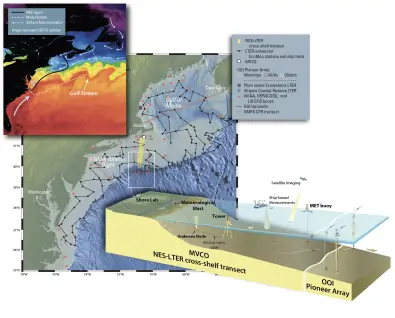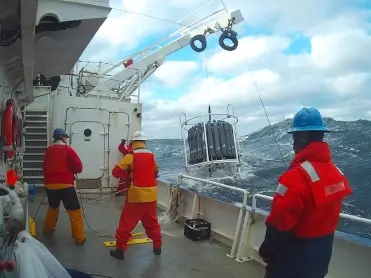Featured Data
Abundance and Biovolume of Taxonomically-Resolved Phytoplankton and Microzooplankton Imaged Continuously Underway with an Imaging FlowCytobot Along the NES-LTER Transect in Winter 2018
May 1, 2020
Susanne Grossman-Clarke
Citation
Sosik, H.M., E. Peacock, and M. Santos. 2020. Abundance and biovolume of taxonomically-resolved phytoplankton and microzooplankton imaged continuously underway with an Imaging FlowCytobot along the NES-LTER Transect in winter 2018 ver 1. Environmental Data Initiative. https://doi.org/10.6073/pasta/74775c4af51c237f2a20e4a8c011bc53.
Description

The NES-LTER (Northeast Shelf Long Term Ecological Research) project integrates long-term observations, process and experimental studies, and models to understand and predict how planktonic food webs are changing on the Northeast U.S. Shelf under climate change, and how those changes impact ecosystem productivity, including higher trophic levels. Seasonal surveys along a high gradient cross-shelf transect are among the long-term observations of the NES-LTER. The transect extends about 150 km southward from Martha’s Vineyard (Figure 1).
The data in this data package include abundance and biovolume of taxonomically-resolved phytoplankton, imaged continuously along the NES-LTER transect during the winter 2018 cruise (Figure 2). Images were obtained with an Imaging FlowCytobot (IFCB) sampling at approximately 20-min intervals from seawater supplied from 5 meters water depth.

Sizes for phytoplankton individuals were determined automatically by image processing. Each individual was manually classified and matched to the lowest possible taxonomic level to the World Register of Marine Species. Data of individuals were aggregated by taxon per sample. In this dataset, as archived in EDI, individual and sample identifiers are linked to images served by an external repository. Altogether, this data package provides 144,281 machine-readable phytoplankton occurrences for incorporation into the Ocean Biogeographic Information System and as Essential Ocean Variables (EOV phytoplankton biomass and diversity) into the Global Ocean Observing System.

The online, open source software tools used for the compilation, summarization, and visualization of phytoplankton taxonomic and size data were developed with the help of EDI 2019 Summer Fellow Katherine Qi. The workflow implemented an intermediate data model to facilitate the standardization to EOVs and the reusability in global information systems. The workflow can be reconfigured for IFCB datasets from other NES-LTER cruises and is being shared with other projects using IFCBs. The workflow GitHub page: https://github.com/klqi/EDI-NES-LTER-2019. Katherine Qi presented a poster featuring the workflow at the Ocean Science Meeting 2020, 16-21 February in San Diego, CA (Figure 3).